
(Download a higher resolution picture by clicking on any
picture below.) 
The Boeing 307 Stratoliner was the largest land-based airliner in its day. It was the first pressurized airliner to go into production. The design of the Boeing 307 was based on the wings and tail of the B-17C Flying fortress. The prototype Stratoliner first flew on January 1, 1938.
 Boeing 307 Stratoliner three-view.
Boeing 307 Stratoliner three-view.
Boeing S-307Stratoliner, NC19903 was delivered to Pan American Airlines on March 22, 1940 at Brownsville, Texas. Its Boeing construction number is 2003. During World War II it flew South American routes under contract to the Army Air Transport Command. Pan Am sold it to Airline Training Incorporated of Homestead, Florida on November 1, 1948. The Haitian Army Air Corps acquired it on December 11, 1953. It was later used as the personal transport of president "Papa Doc" Duvalier. Flight Investment Corporation of Dallas, Texas returned it to the U.S. register as N9307R on September 15, 1959. It was registered as N19903 in 1960. Ewell Nold Jr. of South Houston, Texas bought it on November 12, 1962. It flew for Arkansas Air Freight Incorporated until Inter-American Incorporated of Derby, Kansas bought it on November 23, 1965. Numerous liens were placed against Inter-American and it sold the Stratoliner to Aviation Specialties Company of Mesa, Arizona for $11,667 on May 28, 1969. Aviation Specialties flew it to Falcon Field at Mesa and parked it. That's where I first saw it while attending the 1971 Falcon Field airshow.
 On May 7, 1971, Boeing S-307
Stratoliner N19903 was sitting at Falcon Field, Arizona still wearing the colors of Inter-American Incorporated.
On May 7, 1971, Boeing S-307
Stratoliner N19903 was sitting at Falcon Field, Arizona still wearing the colors of Inter-American Incorporated.
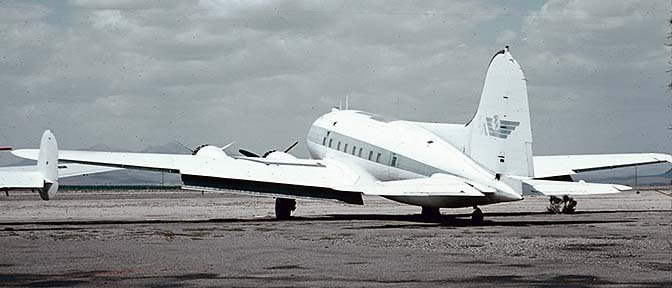 The former Clipper Flying Cloud at
Falcon Field, Arizona on May 7, 1971.
The former Clipper Flying Cloud at
Falcon Field, Arizona on May 7, 1971.
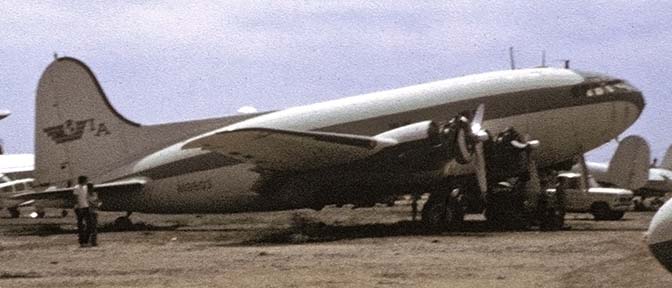 Boeing S-307 Stratoliner, N19903 at
Falcon Field, Arizona in April 1972.
Boeing S-307 Stratoliner, N19903 at
Falcon Field, Arizona in April 1972.
The National Air and Space Museum traded a Lockeheed C-121 Constellation for N199093 on February 20, 1973. N19903 was restored to flying condition for a ferry flight from Falcon Field to Davis-Monthan AFB near Tucson. It was towed from the Air Force Base to the Pima Air Museum.
 Boeing S-307 Stratoliner, N19903 at the Pima Air Museum on March 31, 1974.
Boeing S-307 Stratoliner, N19903 at the Pima Air Museum on March 31, 1974.
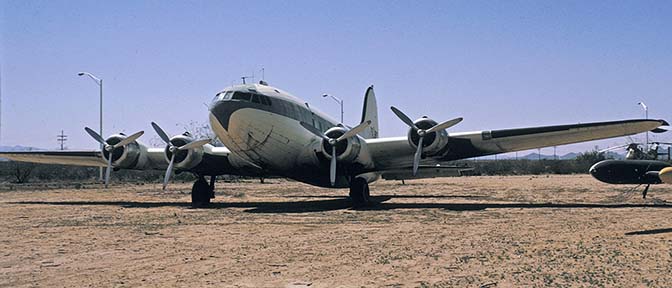 Boeing S-307 Stratoliner, N19903 at
the Pima Air Museum, Arizona on March 31, 1974.
Boeing S-307 Stratoliner, N19903 at
the Pima Air Museum, Arizona on March 31, 1974.
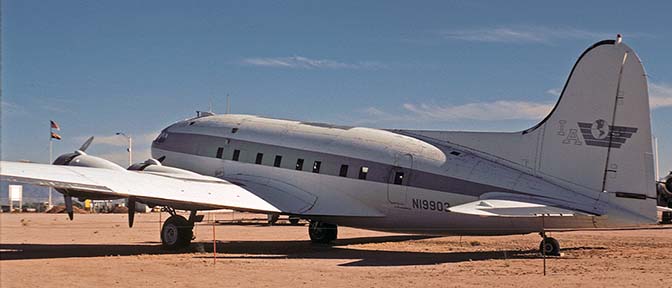 Boeing S-307 Stratoliner, N19903 at
the Pima Air Museum, Arizona on December 18, 1979.
Boeing S-307 Stratoliner, N19903 at
the Pima Air Museum, Arizona on December 18, 1979.
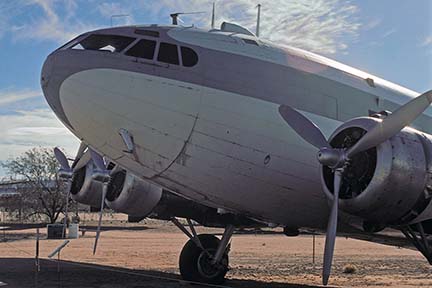 Boeing S-307 Stratoliner, N19903 at
the Pima Air Museum, Arizona on December 18, 1979.
Boeing S-307 Stratoliner, N19903 at
the Pima Air Museum, Arizona on December 18, 1979.
After display to thousands of visitors to the Pima Air Museum over 23 years, Boeing employees "discovered" it while retrieving the 367-80 for restoration in 1996. It was flown to Boeing Field in June 1994.
In the summer of 2001, a Boeing crew completed the complete restoration of the only remaining Boeing 307 Stratoliner, N19903. It appeared at the Experimental Aircraft Association Fly-in at Oshkosh, Wisconcon shortly after restoration.
On March 28, 2002 Clipper Flying Cloud was ditched in Elliot Bay near Seattle. The ditching was largely the result of inattention to the fuel gauges and poor assumptions about how long the Stratoliner could remain airborne with the amount of fuel on board. It appears that "dipping", the method used to determine the amount of fuel aboard, was not sufficiently precise. The pilot began the flight under the impression that they had two hours of fuel aboard. The unique antique airliner ran out of gas after about 45 minutes. They had already made a full-stop landing at Paine. They could have refueled at that time, but they expected to refuel after performing some touch-and-go landings. The number three engine suffered an overspeed on the first take-off from Paine, so the crew elected to return to Boeing field rather than land immediately at Paine Field. The landing at Boeing was delayed by problems extending the main landing gear. The fuel gauges were indicating correctly, but the attention of the crew members was diverted while the landing gear was being hand-cranked down. The Stratoliner's engines died of fuel starvation, so its pilot was forced to ditch the airplane in Elliot Bay, near Salty's Restaurant. The four-man crew suffered only minor injuries.
The Stratoliner was carefully hoisted from the water on March 29, 2002. On June 14, Boeing announced that they intend to restore the Stratoliner to flightworthy condition within a year. Boeing rolled out the restored Stratoliner on June 13, 2003. It is displayed at the National Air and Space Museum's Steven F. Udvar-Hazy Center at Dulles International Airport.
Bob Harrington has posted a number of photos of the recovery operation on his web site, AeroBob Images
NTSB preliminary accident report.
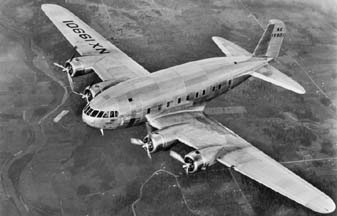 The prototype Boeing 307, NX 19901
flying with two propellers feathered on the right wing. Its
Boeing construction number was 1994. This Stratoliner first flew
on December 31, 1938 and crashed on March 18, 1939.
Representatives of KLM Royal Dutch Airlines were aboard for a
demonstration flight. The KLM pilot asked the Boeing pilot to
shut down two engines on one side of the airplane. The pilot lost
control, and the airplane entered an unrecoverable spin. Ten
people aboard were killed in the crash. The vertical stabilizer
on the Stratoliner was enlarged to provide additional rudder
control authority. The larger stabilizer that had been designed
for the Stratoliner was incorporated in the design of the B-17E
Flying Fortress.
The prototype Boeing 307, NX 19901
flying with two propellers feathered on the right wing. Its
Boeing construction number was 1994. This Stratoliner first flew
on December 31, 1938 and crashed on March 18, 1939.
Representatives of KLM Royal Dutch Airlines were aboard for a
demonstration flight. The KLM pilot asked the Boeing pilot to
shut down two engines on one side of the airplane. The pilot lost
control, and the airplane entered an unrecoverable spin. Ten
people aboard were killed in the crash. The vertical stabilizer
on the Stratoliner was enlarged to provide additional rudder
control authority. The larger stabilizer that had been designed
for the Stratoliner was incorporated in the design of the B-17E
Flying Fortress.
TWA bought six SA-307B Stratoliners and Pan Am bought three S-307 Stratoliners. The TWA Stratoliners served on domestic U. S. routes. Pan Am based their Stratoliners in Miami and used them on Central and South American routes.
Howard Hughes took possession of one of TWA's Stratoliners before delivery to the airline. It was modified to Hughes' specifications for an attempt to set a new record for time to fly around the world and delivered as the only SB-307B.
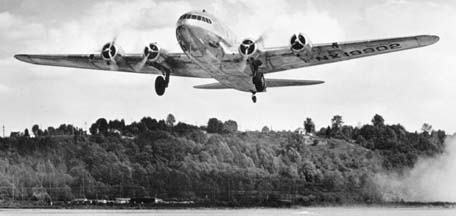 Pan Am Boeing S-307 Rainbow,
NX19902 raises a cloud of dust as it takes off from Boeing Field
in Seattle. This airframe carried Boeing construction number
1995. Boeing Photo 11739.
Pan Am Boeing S-307 Rainbow,
NX19902 raises a cloud of dust as it takes off from Boeing Field
in Seattle. This airframe carried Boeing construction number
1995. Boeing Photo 11739.
Following its service with Pan Am, it passed through the hands of a series of operators. Over the years it was registered as ZS-BWU, HC-SJC-003, F-BHHR, and XW-TAC. It was being operated by the French-Indochina airline Aigle Azur Extreme Orient, registered again as F-BHHR, when it crashed during a storm at Tan Son Nhut Airport in Saigon, Vietnam on May 22, 1961.
 Boeing 307 NC19903 with the original small vertical stabilizer before its delivery to Pan Am. This airframe carries Boeing construction number 2003. Photo courtesy David Davis.
Boeing 307 NC19903 with the original small vertical stabilizer before its delivery to Pan Am. This airframe carries Boeing construction number 2003. Photo courtesy David Davis.
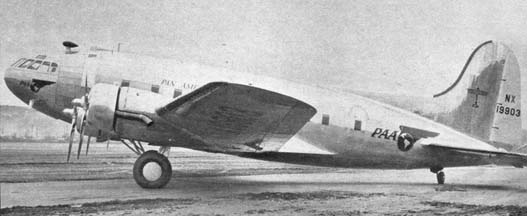 Pan Am Boeing S-307 Clipper Flying Cloud was given the experimental registration NX19903 when an enlarged vertical stabilizer was installed.
Pan Am Boeing S-307 Clipper Flying Cloud was given the experimental registration NX19903 when an enlarged vertical stabilizer was installed.
 S-307 Clipper Flying Cloud on an
early flight over Seattle, Washington.
S-307 Clipper Flying Cloud on an
early flight over Seattle, Washington.
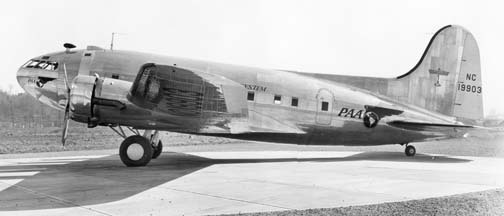 Pan Am Boeing S-307 Clipper Flying
Cloud on March 18, 1940. It has been re-registered as NC19903.
Boeing photo 12329B.
Pan Am Boeing S-307 Clipper Flying
Cloud on March 18, 1940. It has been re-registered as NC19903.
Boeing photo 12329B.
 Vertical stabilizer of Pan Am
Boeing S-307 Clipper Flying Cloud. Note the Boeing
"bug" trademark.
Vertical stabilizer of Pan Am
Boeing S-307 Clipper Flying Cloud. Note the Boeing
"bug" trademark.
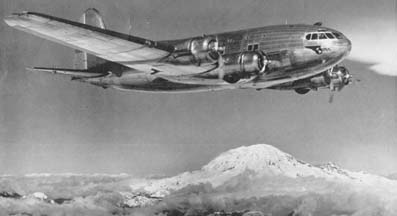 Clipper Flying Cloud, NC19903 over
Mt. Ranier, Washington. Boeing posed its new aircraft types over
Mt. Ranier for publicity shots.
Clipper Flying Cloud, NC19903 over
Mt. Ranier, Washington. Boeing posed its new aircraft types over
Mt. Ranier for publicity shots.
Following its service with Pan Am, the various owners of the former Clipper Flying Cloud registered it as ZS-BWV, Haiti No. 2003, N9307R, and finally N19903.
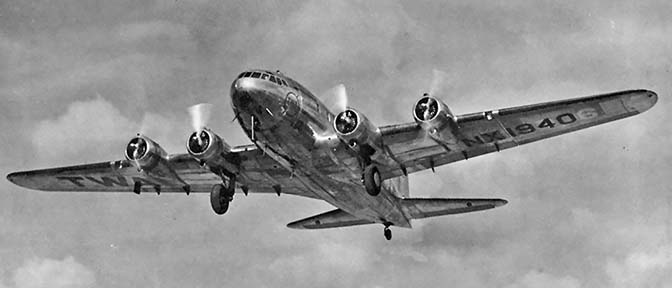 Boeing SA-307B Stratoliner NX1940
in pre-war service with TWA. The original registration of this
Stratoliner was NX19906, and it carried Boeing construction
number 1998. TWA changed the registration for a publicity
campaign that featured the Boeing SA-307B as the airliner for
1940. The brighter bare metal reveals where the 6 was removed and
the second 9 was changed to a 4.
Boeing SA-307B Stratoliner NX1940
in pre-war service with TWA. The original registration of this
Stratoliner was NX19906, and it carried Boeing construction
number 1998. TWA changed the registration for a publicity
campaign that featured the Boeing SA-307B as the airliner for
1940. The brighter bare metal reveals where the 6 was removed and
the second 9 was changed to a 4.
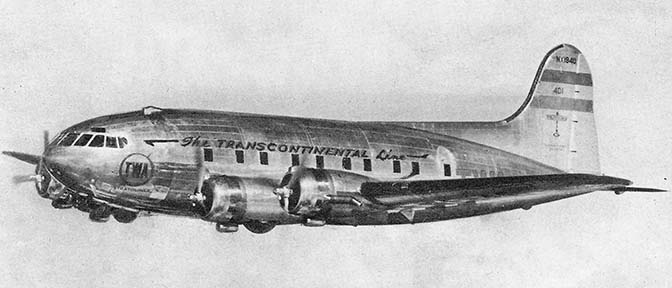 Boeing SA-307B Stratoliner NX1940
in pre-war service with TWA. Barely visible under the wing are
the external flap hinges that distinguished the TWA SA-307B from
the Pan Am S-307.
Boeing SA-307B Stratoliner NX1940
in pre-war service with TWA. Barely visible under the wing are
the external flap hinges that distinguished the TWA SA-307B from
the Pan Am S-307.
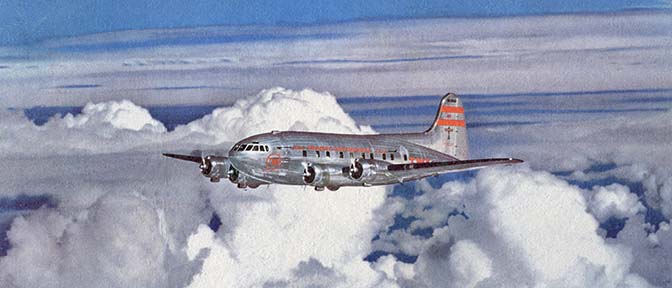 Color publicity photo of TWA Boeing 307 Stratoliner N1940 flying
above the weather. Following their retirement by TWA, four of the
SA-307B-1 Stratoliners were sold to the French airline Aigle Azur
in 1951. N1940 was registered as F-BELU. It was flying for Royal
Air Lao registered as XW-TFP when it crashed into the Mekong River near the Thai border
with Laos on March 13, 1975. The two man crew was captured by
the Pathet Lao and held captive for several months.
Color publicity photo of TWA Boeing 307 Stratoliner N1940 flying
above the weather. Following their retirement by TWA, four of the
SA-307B-1 Stratoliners were sold to the French airline Aigle Azur
in 1951. N1940 was registered as F-BELU. It was flying for Royal
Air Lao registered as XW-TFP when it crashed into the Mekong River near the Thai border
with Laos on March 13, 1975. The two man crew was captured by
the Pathet Lao and held captive for several months.
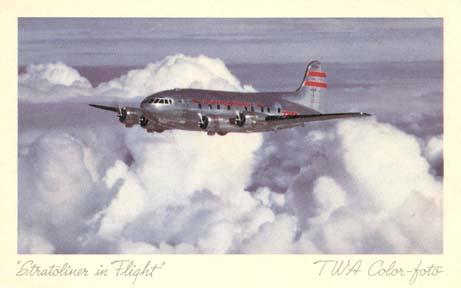 The photo above was the subject of a popular
postcard from the 1940s.
The photo above was the subject of a popular
postcard from the 1940s.
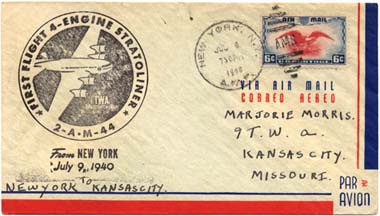 Postal cover carried on the first
TWA Boeing 307 Stratoliner flight from New York to Kansas City.
It was cancelled in New York on September 8, 1940 and stamped
received in Kansas City on September 10.
Postal cover carried on the first
TWA Boeing 307 Stratoliner flight from New York to Kansas City.
It was cancelled in New York on September 8, 1940 and stamped
received in Kansas City on September 10.
 Reverse of the envelope pictured
above.
Reverse of the envelope pictured
above.
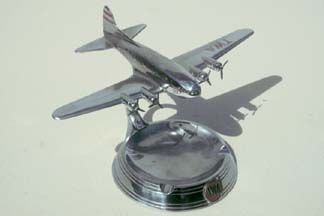 This ashtray featuring a chrome
plated model of a TWA Boeing SA-307B Stratoliner was manufactured
by Pastushin in the early 1940s
This ashtray featuring a chrome
plated model of a TWA Boeing SA-307B Stratoliner was manufactured
by Pastushin in the early 1940s
During World War II, the TWA SA-307B Stratoliners were inducted into the Army Air Force under the designation C-75 and received AAF serial numbers. The Pan Am S-307 Stratoliners kept their civil registrations, but they were operated primarily to serve the needs of the military.
TWA crews operated the C-75s for the Air Transport Command. They were assigned to trans-Atlantic duty, first across the South Atlantic from South America to Cairo, Egypt, and later across the North Atlantic to London, England.
Howard Hughes' plans to fly around world were interrupted. His Stratoliner was not flown from September 1939 to May 1947.
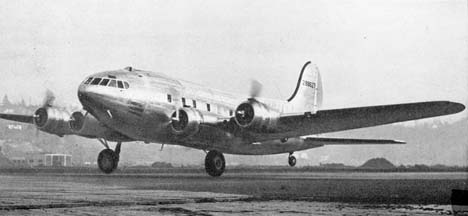 First TWA Boeing SA-307B, NC19909
to be converted to the SA-307B-1 configuration during tests at
Boeing's Seattle plant after the war. This airframe carried
Boeing construction number 2001. It still carries the Army Air
Corps serial number, 42-88627 that it carried as a C-75. The
original B-17C style wings and horizontal stabilizer were
replaced with B-17G style units. The horizontal stabilizer was
mounted three feet farther to the rear. The new wing lacks the
external flap hinges of the original. The 900 hp Wright GR-1820
Cyclone engines were replaced with 1,200 hp R1829 engines. The
pressurization system was removed to reduce weight.
First TWA Boeing SA-307B, NC19909
to be converted to the SA-307B-1 configuration during tests at
Boeing's Seattle plant after the war. This airframe carried
Boeing construction number 2001. It still carries the Army Air
Corps serial number, 42-88627 that it carried as a C-75. The
original B-17C style wings and horizontal stabilizer were
replaced with B-17G style units. The horizontal stabilizer was
mounted three feet farther to the rear. The new wing lacks the
external flap hinges of the original. The 900 hp Wright GR-1820
Cyclone engines were replaced with 1,200 hp R1829 engines. The
pressurization system was removed to reduce weight.
SA-307B-1, NC19909 was sold to Aigle Azur and registered as F-BELZ in 1951. It crashed into a cliff on Monte Renosa near Ajaccio, France on December 29, 1962, killing all 25 in board.
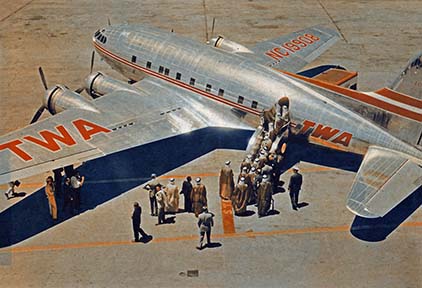 TWA Boeing SA-307B-1 NC19908 in
post-war service with TWA. This airframe carried Boeing
construction number 2000. The original B-17C style horizontal
stabilizer has been replaced with the larger stabilizer design of
the B-17G. Note that the elevator hinge line is even with the
rudder hinge line.
TWA Boeing SA-307B-1 NC19908 in
post-war service with TWA. This airframe carried Boeing
construction number 2000. The original B-17C style horizontal
stabilizer has been replaced with the larger stabilizer design of
the B-17G. Note that the elevator hinge line is even with the
rudder hinge line.
SA-307B-1, NC19908 was sold to Aigle Azur and registered as F-BELY in 1951. It was operated by Royal Air Lao registered as XW-PGR when it was written off at Luang Prabang, Laos on February 27, 1971. There is no other information available about this crash.
After the war, Hughes sold his Stratoliner SB-307B, NC19904 to Glen McCarthy of Texas. The airplane was written off after a hurricane hit the airport where it was parked in Florida.
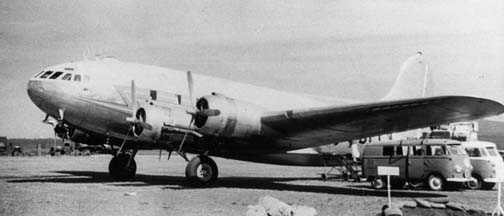 SA-307B-1 F-BELX at Pleiku, South
Viet Nam in 1962. It was originally registered as NC19905 by TWA
and its Boeing construction number was 1999. TWA sold it to the
French airline Aigle Azur in 1951. It was one of three SA-307B-1s
based in Saigon. The French registered Stratoliners operated
under U.S. control, but they were the only civil aircraft allowed
to operate between Saigon and Hanoi. Photographer: Daniel
Gressang
SA-307B-1 F-BELX at Pleiku, South
Viet Nam in 1962. It was originally registered as NC19905 by TWA
and its Boeing construction number was 1999. TWA sold it to the
French airline Aigle Azur in 1951. It was one of three SA-307B-1s
based in Saigon. The French registered Stratoliners operated
under U.S. control, but they were the only civil aircraft allowed
to operate between Saigon and Hanoi. Photographer: Daniel
Gressang
 F-BELX was later sold to Cambodia
Air Commercial and registered XW-TFR.
F-BELX was later sold to Cambodia
Air Commercial and registered XW-TFR.
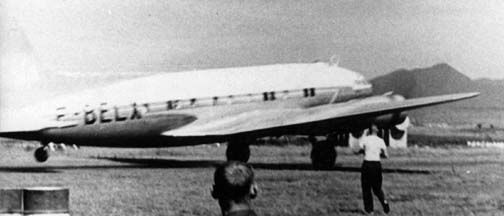 This Stratoliner crashed three minutes after taking off from the
Battambang Airport in Cambodia on June 27, 1974, following
the loss of power from three engines. Nineteen of the thirty-nine
people on board were killed.
This Stratoliner crashed three minutes after taking off from the
Battambang Airport in Cambodia on June 27, 1974, following
the loss of power from three engines. Nineteen of the thirty-nine
people on board were killed.
It should be noted that five of the eight Boeing 307 Stratoliners to enter airline service were lost in crashes in Loas, Cambodia, and Viet Nam between 1961 and 1975. One of them was shot down by a U.S. fighter due to "misidentification".
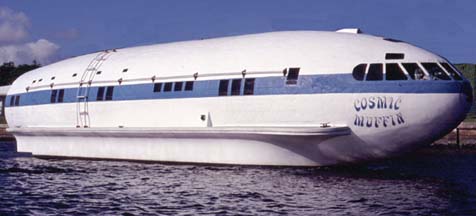 The fuselage of Howard Hughes
Stratoliner SB-307B, NC19904 has been converted to a houseboat
and is named Cosmic Muffin. It is available for charter
in Florida. Photo courtesy Plane Boats Inc.
The fuselage of Howard Hughes
Stratoliner SB-307B, NC19904 has been converted to a houseboat
and is named Cosmic Muffin. It is available for charter
in Florida. Photo courtesy Plane Boats Inc.
Link to the web site of the unique Stratoliner
houseboat, the Cosmic
Muffin.![]()
Airliners of the 1930s |
|||||||
| First Flight | Wing Span | Length | Passengers | Wing Area | Gross Weight | Engines | |
| Boeing 314 | 1938 |
152ft,00in |
106ft,00in |
74 |
2,607 |
82,000 |
4 x 1,200 hp R2600 |
| Boeing 307 Stratoliner | 1938 |
107ft,03in |
74ft,04in |
30 |
1,486 |
42,000 |
4 x 900 hp R1820 |
| Douglas DC-3 | 1935 |
95ft,00in |
62ft,00in |
24 |
987 |
28,000 |
2 x 1,000 hp R-1830 |
| Douglas DC-1 | 1933 |
85ft,00in |
60ft,00in |
12 |
942 |
17,500 |
2 x 690 hp SGR-1820 |
| Boeing 247 | 1933 |
74ft,00in |
51ft,04in |
10 |
836 |
12,650 |
2 x 550 hp Wasp S1D1 |
Link to Boeing's June 19 press release about the rollout of the restored Clipper Flying Cloud.
Link to the the Aviation Group's page describing the Boeing 307.
Link to the Aviation Safety Network's list of Boeing 307 crashes.
Maquette of Russia has released a 1/72-scale model kit of the Boeing 307 Stratoliner.
 Send a message to Brian.
Send a message to Brian.